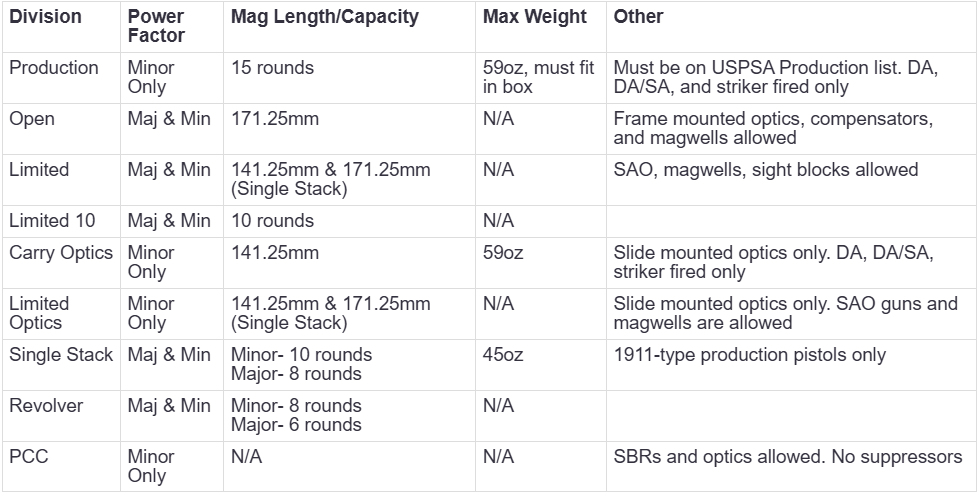And we're back for Part IV with USPSA divisions. Let's get right to it.
Divisions
Your chosen division determines which firearms, modifications, and equipment are legal to use. You may choose your own division for any match you compete in. However, if you are new to competitive shooting it is best to use what you already have and decide which division your firearm and equipment fall into. There is so much to learn already, and you don’t want to spend a bunch of money or effort trying to fit into a particular division. By the end of this section, you should know which division you fit into or where you may end up competing down the road.
With a basic understanding of power factor and scoring from Parts II and III, let’s get into the divisions. Below is a table giving a very brief overview of each. Refer to the rulebook for further information and I will briefly describe them below.

*Additional note: Keep in mind that the gun does not make the shooter. Each competitor in a particular division has the same equipment advantages as the next and a race gun will not make you a Grandmaster. My advice for new competitors is to choose the division that fits your equipment or appeals to you most.
Production
Production division was once the heart of USPSA and where many competitors get their start. Much like SSP in IDPA, Production is where you will find off the shelf, mass-produced handguns with few modifications and iron sights. The Production magazine capacity limit was recently raised to 15 rounds from 10. This is the division, next to Carry Optics, most people will fall into without buying competition specific gear.
Open
Open division guns (AKA race guns) are the top fuel dragsters of competitive shooting. There is no max weight, and the largest magazines are allowed. Many modifications are permitted, including magwells, frame mounted red dots, and compensated or ported barrels. Open uses both minor and major scoring. If you want to be competitive in this division, definitely do some research into the platform and cartridge you should use.
Limited & Limited 10
Limited is similar in spirit to Open. Here you will often find heavily modified race guns. The main difference is compensators and optics are not allowed in this division. The minimum caliber for major scoring is .40 S&W. Again, minor and major are allowed.
Carry Optics
With the rise in red dot usage on handguns (about time), CO/Ghetto Open has become the most popular division in USPSA, for good reason. The DA, DA/SA, and striker fired requirement along with the 141mm magazine size mixes some elements from both Production and Limited. This means most competitors can take their favorite handgun, slap a red dot on top, grab some magazine extensions, and quickly be competitive (as far as equipment goes) in the division. This division is minor scoring only. Magwells and compensators are not permitted. No single-action only guns (no 1911/2011s)
Limited Optics
A new division by popular demand. Virtually any minor PF Limited gun with a slide mounted red dot or Carry Optics gun can compete here. This is the place for 2011s and other single action only handguns. No compensators or ported barrels.
Single Stack
In short, Single Stack is the 1911 division. Per the rulebook, only 1911 type production pistols are allowed. Both minor and major PF are permitted. Although this division is less popular, competing with a 1911 can be a lot of fun. So, if you want to LARP as your great-grandpa, this is the division for you.
Revolver
Another less than popular division these days. You won’t find a lot of competition here, but it can still be plenty of fun to shoot. Bring your favorite wheel gun and lots of speed loaders. Reference the rulebook for more information and specific equipment rules.
Pistol Caliber Carbine (PCC)
This division is self-explanatory. PCC has become very popular in some circles. I can’t say it’s my favorite, but I see the appeal. This division is here so you can shoot something in rifle form at a pistol match.
That does it for divisions. The full set of rules around competitive divisions can be found in Appendix D of the USPSA rulebook. As always, feel free to contact me directly if you have questions about your division. Check out Part V where we wrap up the series with a look at the USPSA classification system and an example classifier stage.
Current USPSA rules (as of this writing) are available at the link below.
USPSA Rulebook: https://uspsa.org/viewer/2024-USPSA-Competition-Rules.pdf
